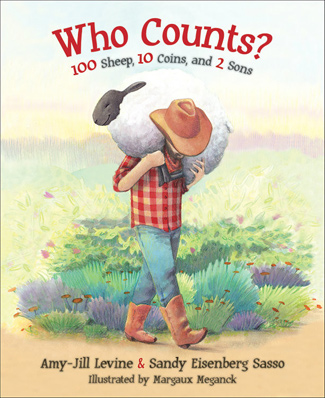
Listen to Amy-Jill Levine discuss her new book for the Divinity Library’s “Authorial Intentions” interview series.
Amy Jill Levine, a Vanderbilt New Testament scholar, is the co-author of a new children’s book that imaginatively retells three of Jesus’ parables from the perspective of a first-century Jewish audience.
Who Counts? 100 Sheep, 10 Coins, and 2 Sons (Westminster John Knox, 2017) was co-written by Levine, University Professor of New Testament and Jewish Studies, and Rabbi Sandy Eisenberg Sasso, best-selling children’s book author and Butler University faculty member.
The beautifully illustrated volume looks at three popular parables in Luke 15—the Lost Sheep, the Lost Coin, and the Prodigal Son. The pictures set the three parables in modern time using multicultural, multiracial figures.
“I was lamenting to Sandy about the lack of thought-provoking children’s books on parables,” said Levine, who wrote Short Stories by Jesus: The Enigmatic Parables of a Controversial Rabbi (HarperOne, 2014). “Children like to think, they like to be challenged. We decided the best approach would be to use our historical knowledge to explore what first-century Jews would have heard when listening to the parables, and we found that the messages are timeless.”
Levine, who is also the Mary Jane Werthan Professor of Jewish Studies, explained that by the time the parables are written in the Gospels, they have already been through at least one round of interpretation. “Jesus told the parables, likely using different words with each iteration, just as storytellers do today,” she said. “Someone had to translate Jesus’ stories from Aramaic into Greek and set them in a particular place in the Gospel. In some cases, Jesus’ followers added interpretations to the parables, which is what all good readers of stories do.”

Levine said that she and Sasso are taking a step back in time—before the parables entered the written texts of the Gospels—to try to hear the stories as told by a Jewish man to other Jews.
“We are not calling into question any Christian belief or doctrine,” Levine said. “We are just trying to add one more layer to the profundity of Jesus by show that the parables are even more challenging and provocative than most people realize.”
Levine, whose numerous books about the New Testament and early Christianity include The Jewish Annotated New Testament (co-edited with Marc Brettler and published by Oxford University Press), said that writing a children’s book presents new challenges from her usual scholarship.
“I had a sense, having written a parables book for adults, of what I wanted to say,” Levine said. “However, Sandy, as a longtime children’s book author, was much better at knowing the right words and sentence length to use with young readers,” Levine said.
With the Parable of the Prodigal Son, the illustration depicts a happy father putting his arm around his oldest son, who looks extremely angry. “The eldest son is really upset because he was not invited to the party celebrating the return of the younger son,” Levine said. “Parents and teachers can ask children why they think the oldest son was upset and if they’ve ever felt that way.” A note at the back to adult readers offers other suggestions on how to read the parables, including questions to ask children to help them engage the stories.
Publisher Westminster/John Knox has already moved the volume into a second printing, based on its initial popularity. A second volume on the Parable of the Mustard Seed is now with the illustrator, and the press has asked Levine and Sasso to do two more volumes.
Levine and Sasso are confident that young readers are up to the challenge of reading the parables. “Children truly enjoy stories that invite them to ask questions and offer their valued opinions on the meaning,” Levine said. “The parables are timeless in that they continue to spark questions that are simple yet extraordinarily profound.” Adults too, she suggests, can also appreciate the challenge as well as the humor of the parables.